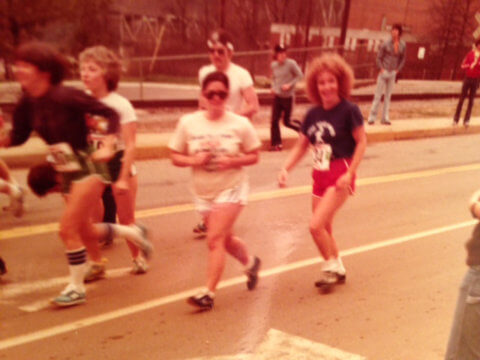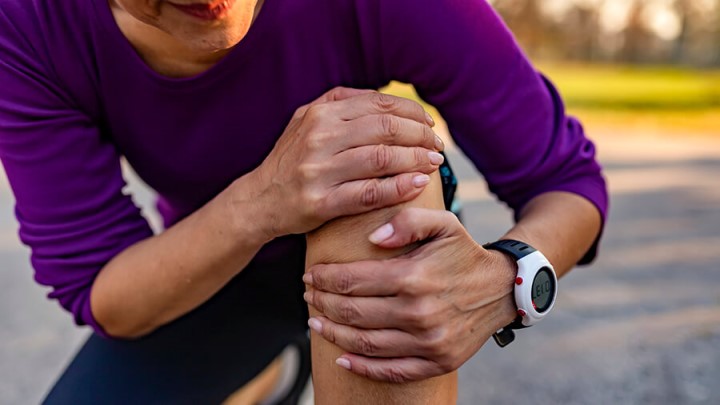I discovered a love for running at age 23. Living in Alexandria, Virginia, in the late 1970s, I would huff and puff past the Potomac. Jogging, as we called it back then, was just beginning to blossom into a national phenomenon—not quite yet a craze. Fun runs filled the weekends, and a rainbow of T-shirts lined my dresser drawers.
I found my passion for Jazzercise at 27. Living in Knoxville, Tennessee, in the mid-1980s, I would shimmy and shake in a sea of women decked in bright leotards, tights, and headbands.
In my 30s, I headed to the Great Smoky Mountains every weekend to hike with my friend Beverly. The bigger and harder the goals, the better.
In my 40s, feeling ridiculously proud of my fitness after a solo birthday hike, I noticed a feeling like bubblegum in my knees. Instead of being well-oiled and fluid, my knees felt clogged up.
Bubblegum Knees

her friend Beverly (in the red shorts to her right) in the ’70s.
The sensation persisted, so I went to an orthopedist, the knee doc to the local university’s football team. He pronounced the problem arthritis and me an exercise addict. This latter felt dismissive, as if my passion for activity was unimportant. How could he be giving me—the exercise queen who was in her 40s and not her 70s—this diagnosis?
His solution: Pull back and trade the activities I loved for lower-intensity ones. He also suggested trying ibuprofen and cortisone injections.
Thus began a knee health journey that continues to evolve. The old-school doc would have had me confined to a stationary bike, rower, and swimming pool—in a word, boring! I sought out other orthopedists and alternative healers whose thinking was more modern and in alignment with my own.
For me the sweet spot lies in movement and natural healing rather than surgery and medication. While knee replacements seem to be a common fix these days, there are several less invasive—even fun—alternatives for joint relief. Here’s what I’ve found.
Heating Things Up
It was through a floor barre class by “Mr. C.,” a former Alvin Ailey dancer, that I found hot yoga. Six years ago, Mr. C. thought yoga would be a great addition to my repertoire when I wanted to shape up for my high-school reunion.
Hot yoga (formerly called Bikram yoga in many studios) provided some of the same great benefits as running, without the impact on my joints. The yoga series is designed to methodically warm and stretch muscles, ligaments, and tendons in a specific order, as well as to stimulate all the organs, glands, and nerves.
I quickly work up a sweat in the room heated to 105 degrees with 40 percent humidity. Some of the moves, while subtle, raise my heart rate. The class achieves a good mix of aerobic, strength, flexibility, and balance work. The cares of the world fade away in the hot room, my mind always feels better—and my knees usually do, too. Hot yoga prices vary by location; in Atlanta, I pay $99 per month for an unlimited pass and have been very happy with the practice.
Yes, This Involves a Needle
Another thing I’ve tried is one that’s gaining popularity: Platelet rich plasma (PRP) injections, a nonsurgical treatment that harnesses the healing power of your own blood to reduce joint pain caused by inflammation. The procedure involves taking blood from your arm and spinning it in a centrifuge to separate out the concentrated growth factors in the plasma that your body can use to mend cells and tissue. The platelet-rich plasma then gets injected into the knee; because it comes from your own blood, there is no chance of the body rejecting it.
Superstars like Tiger Woods and ordinary active individuals like me have benefitted. “PRP has the ability to reduce pain in your knee and hopefully slow down further wear and tear of your cartilage,” according to Dr. Kenneth Mautner, a sports medicine physician with Emory Sports Medicine Center in Atlanta. In his experience and in studies he has done, about 75 percent find pain relief with a PRP injection. Many factors help to determine success. For instance, the milder a patient’s arthritis, the longer the relief from pain. Many patients do injections every year or two; others come back after several years as symptoms dictate.
My left knee did amazingly well after an injection. Back at yoga a couple of weeks later, I realized I had been in the habit of stopping at points in the class sequence because my knees hurt. Thanks to PRP, I didn’t need to do that.
One drawback to PRP injections is their cost. Mautner says they range from about $500 to $2,000 per injection across the United States. Insurance often doesn’t cover the procedure even though it is a promising treatment, according to Mautner. The insurance companies “don’t think there’s enough evidence, which is why we have an ongoing need for research and trials,” he says. “I would argue they pay for a lot of things that have less evidence already.”
For those considering PRP for osteoarthritis, Mautner suggests finding a licensed physician with experience in knee conditions who is doing research in the field. To learn more about research studies worldwide that recruit candidates, visit https://clinicaltrials.gov.
A Different Kind of Needle

Acupuncture has provided less expensive but shorter-term relief for my knee problems. Though I used to be afraid of having slender bits of metal wedged into my body, I’m now the kind of person who would rather be needled than take ibuprofen or any medication with possible side effects.
The prevailing wisdom is that acupuncture is a noninvasive alternative that can help reduce inflammation and pain in the knee; acupuncture points are believed to stimulate the central nervous system and the body’s natural healing abilities. My acupuncturist, however, would say my knee problems result from blocked energy, and that’s what we aim to correct. I lie on a nice warm table in a peaceful room overlooking a field of trees as he applies thin needles to open up the energy flow and improve my health. He also uses electricity (yes, I know it sounds scary, but it’s very mild) that generates currents to accelerate healing.
I go in for a session ($75 a pop) on an as-needed basis and have stopped counting how many needles he inserts, which was my habit in my initial, more phobic stage. Now, I enjoy the experience and the results I’ve been getting. I walk out with more ease and more range of motion in my knees.
That’s always the goal: to mix and match noninvasive treatments to remain agile and active. Who knows what new healing possibilities will unfold in the years to come.
[Published on NextTribe.com, August 14, 2019]

